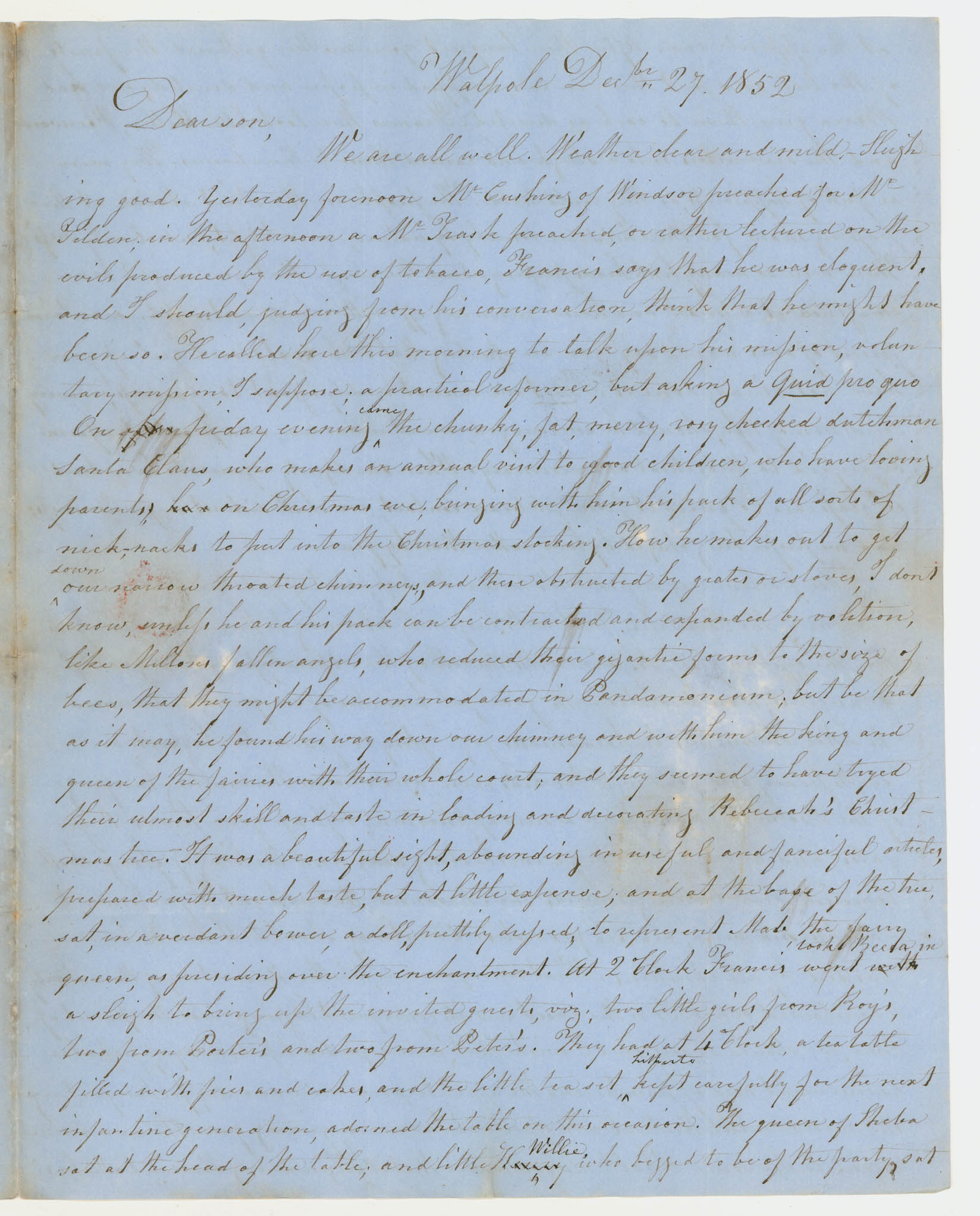By Susan Martin
On friday evening came the chunky, fat, merry, rosy cheeked dutchman Santa Claus, who makes an annual visit to good children, who have loving parents, on Christmas eve, bringing with him his pack of all sorts of nick-nacks to put into the Christmas stocking. How he makes out to get down our narrow throated chimneys, and these obstructed by grates or stoves, I dont know, unless he and his pack can be contracted and expanded by volition, like Miltons fallen angels, who reduced their gigantic forms to the size of bees, that they might be accommodated in Pandamonium…
This Christmas letter from Jacob Newman Knapp (1773-1868) to his son Frederick, written on 27 Dec. 1852, is just one of many interesting letters in the Knapp family correspondence, a new collection at the MHS.

Jacob’s long life stretched from the American Revolution to the Civil War. He had been a teacher for many years and now lived on a farm in Walpole, N.H. with his wife Louisa (Bellows) Knapp and Frederick’s younger brother Francis. Frederick was minister of the First Parish Church in Brookline, Mass. The family was obviously very close, and letters were frequent and affectionate. Jacob’s in particular, though not short on paternal advice, also reveal a playful and endearing sense of humor.
Christmas at the Knapp home that year was a big event. The guest of honor was a young girl named Rebecca. Rebecca’s name had suddenly appeared in the correspondence just a few days earlier, and any letter indicating who she was or why she was staying with the family has since been lost. Neither Frederick nor Francis was married or had children yet, so I assumed Rebecca was the daughter of a friend or distant relative, or perhaps the child of a servant. The Knapps were known for their hospitality, and Jacob and Louisa seem to have taken this girl under their wing. Whoever she was, she was fêted in grand style, with her very own Christmas tree, a Queen Mab doll, sleigh rides, and afternoon tea with seven other children of Walpole.
One of my favorite passages in the letter is Jacob’s description of a sleigh ride with Rebecca and the other children. He was obviously a natural storyteller, painting a vivid picture for us:
They were as full of happiness, as they could hold. The people in the street stared at the passing show, for the children, comely by nature, were bright, and cleanly dress’d. There were so many little heads peeping above the sleigh, that you might have imagined it a man and horse running off with a birds nest.
Then this fascinating detail:
Ah! a certain friend of ours would say, “you are spoiling that little coloured girl, if you have not already done it.” That we cannot readily assent to. Goodness, in every condition of life, should be encouraged, merit rewarded, and practical reform be prefer’d to theoretical and visionary. When our dignity requires to be enclosed in a glass case to guard it from plebean contact, we shall distrust in generousness, and we prefer being obeyed by love, rather than by fear.
I was more intrigued than ever. Who was Rebecca? A few other letters in the collection contain passing references to her, but nothing more. I consulted published biographies of the Knapps, but turned up nothing.
On 27 June 1853, Rebecca left the Knapp household under the care of a Mr. Makepeace, probably Walpole resident George R. Makepeace. The last letter in the collection is dated a few days later. In it, Jacob tells Frederick: “Rebecca’s safety was well cared for, as much so, as if her complexion had been a combination of white and red. She is a good girl, and will, I hope, continue so.”

